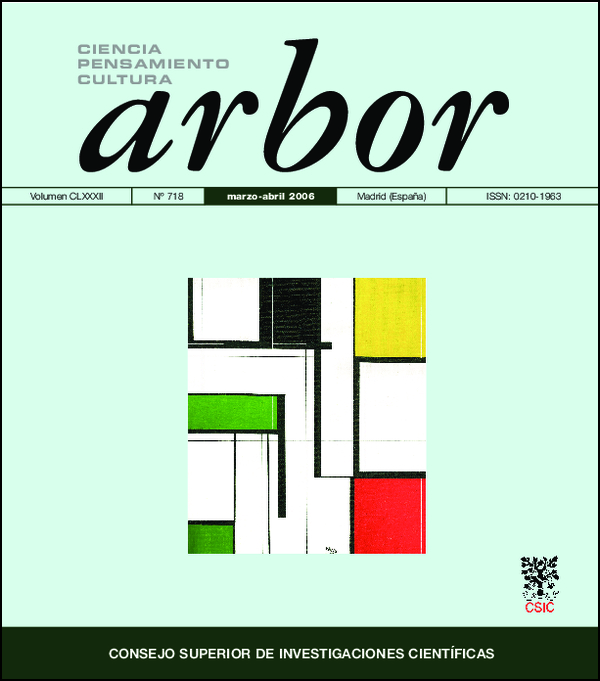La tinta invisible: Darwin y la fuerza de la herencia
DOI:
https://doi.org/10.3989/arbor.2006.i718.23Keywords:
Darwin, Genealogy, Inheritance, VariationAbstract
In this paper we analyze the way in which Darwin interpreted some notions of the problem of inheritance. First we describe how he used various nineteenth century categories of inheritance: atavism, constitution, genealogy, prepotency and morbid tendency. Afterward, by identifying in his texts these categories it is shown that his investigation on the transformation of species was conceptually linked with the problem of inheritance but his interpretation differed with hereditarism, the dominant point of view from which the history of the research on inheritance has been written.
Downloads
References
Barrett, P. H., et al. (1987): Charles Darwin’s notebooks, 1836-1844: Geology, transmutation of species, metaphysical enquiries, Ithaca: British Museum (Natural History) y Cornell University Press.
Churchill, F. B. (1987): “From heredity theory to Vererbung: the transmission problem, 1850 – 1915”. ISIS, 78: 336-364. doi:10.1086/354472
Darwin, Ch. (1868): The variation of animals and plants under domestication. London, John Murray. 2 Vols.
Darwin, Ch., (1871): The descent of man and selection in relation to sex. Facsímil de la primera edición. 2 vols. Princeton University Press. [1981].
Darwin, Ch. (1872): The Origin of Species, Oxford University Press, Reimpresión de la edición de 1956.
Darwin, Ch. (1876): The effects of cross and self-fertilization in the vegetable Kingdom. London, John Murray.
Darwin, Ch. (1881): “Inheritance”. A Weekly Illustrated Journal of Science. 24: 257.
Darwin, Ch. (1883): The variation of animals and plants under domestication. The Johns Hopkins University Press, Reeditada de la segunda Edición, 1998, 2 Vols.
Darwin, F. (1909): The foundations of the Origin of Species: two essays written in 1842 and 1844 by Charles Darwin. Cambridge.
Di Gregorio, M. A. (1990): Charles’s Darwin Marginalia. Garland Publishing, INC.
Gayon, J. (1998): Darwinism’s struggle for survival: heredity and the hypothesis of Natural selection. Cambridge University Press.
Galton, F. (1914): Hereditary Genius. London: Macmillan.
Galton, F. (1889): Natural inheritance. Genetics Heritage. Press, New Mexico. (ed. Facsimilar, 1997).
Hodge, M. J. S. (1985): “Darwin as a Lifelong generations theorist”. En David Kohn (ed.) The Darwinian Heritage. Princeton University Press. Pp. 207- 244.
López Beltrán, C. (1992): Human Heredity 1750-1870; The Construction of a Domain. Tesis doctoral. University of London.
López Beltrán, C. (2004): El sesgo hereditario. Ámbitos históricos del concepto de herencia biológica. UNAM, México.
Lucas, P. (1847-1850): Traité philosophique et physiologique de l´heréditéNaturelle dans les états de santé et de maladie du systéme nerveux, 2 vols., París, J. B. Bailliére.
Mendel, G. (1866): Experimentos de hibridación en plantas. A. Prevosti (traductor). UNAM, México.
Noguera Solano, R. y Ruiz Gutiérrez, R., (2005): “Pangénesis y vitalismo científico”, Asclepio, 57: 219-236.
Vorzimmer, P. J. (1977): “The Darwinian reading Notebooks (1838-1860)”. Journal of the History of Biology, 10: 107-153. doi:10.1007/BF00126097 PMid:11615636
Winther, R. G. (2000): “Darwin on Variation and Heredity”. Journal of the History of Biology. 33: 425-455. doi:10.1023/A:1004834008068
Downloads
Published
How to Cite
Issue
Section
License
Copyright (c) 2006 Consejo Superior de Investigaciones Científicas (CSIC)

This work is licensed under a Creative Commons Attribution 4.0 International License.
© CSIC. Manuscripts published in both the printed and online versions of this Journal are the property of Consejo Superior de Investigaciones Científicas, and quoting this source is a requirement for any partial or full reproduction.All contents of this electronic edition, except where otherwise noted, are distributed under a “Creative Commons Attribution 4.0 International” (CC BY 4.0) License. You may read here the basic information and the legal text of the license. The indication of the CC BY 4.0 License must be expressly stated in this way when necessary.
Self-archiving in repositories, personal webpages or similar, of any version other than the published by the Editor, is not allowed.














